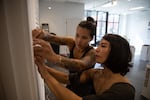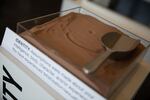Scalehouse Gallery in Bend, Oregon opened a show on Friday, August 6th provocatively titled, “Be Nice White, You’re in Bend.” The artists behind the exhibit are a collective that began as an informal Facebook post hoping to connect people of color in Central Oregon during the pandemic.
They gave their Facebook group a utilitarian name that they believed would help others find them. And now the collective known as Central Oregon Black, Indigenous, People of Color or COBIPOC has expanded from its virtual gathering space to online zines and now, the walls of a gallery.
Two of COBIPOC’s members sat down with Arts & Culture producer, Claudia Meza to discuss this evolution.

Bear Patton (left) and Taemi Izumi hang name placards for the Be Nice (White) You're In Bend exhibit at Scalehouse in Bend, Ore., on Aug. 6, 2021.
Bradley W. Parks / OPB
Claudia: If you ever visit Bend, Oregon you might come across the expression, “Be Nice, You’re in Bend.” And as innocuous as the statement appears there are some Bend residents that feel there are hidden implications to its meaning. With me today to talk about their art show, “Be Nice White, You’re in Bend” is COBIPOC’s lead artist and founder, Bear Patton, and its lead designer and creative director, Taemi Izumi.
Bear, could you start us off by explaining why you chose that title?
Bear: Yeah. I can speak to it first. So there is a bumper sticker. It’s a super popular sticker in Bend. There are two versions of it, one says, “Keep Bend Nice” and the other one says, be nice dot, dot, dot you’re in Bend. It got me thinking, what does it mean to be nice and what is that communicating to somebody like me or to somebody who is another black indigenous person of color. It communicates to us that as BIPOC we need to make ourselves invisible to be here. And that this version of niceness is so often used almost as a tool to keep us quiet and keep us small.
Claudia: Taemi, would you like to add to anything to what Bear just said.
Taemi: Yeah. I second that. I think, you know, Bend is a nice place. There are people, strangers wave to each other and smile in the streets and, you get to a four-way stop sign and everyone’s always waving you on. People are very nice, but I think that, as Bear said, it’s this idea of not rocking the boat and of not speaking out against injustices, and leaving the status quo and with Black Lives Matter and our group and BIPOC across the United States, the idea is to stand up and, you know, say this stuff is not acceptable anymore. And so saying be nice is like saying, be quiet, be white.

Programs for the Be Nice (White) You're In Bend exhibit on display at Scalehouse in Bend, Ore., on Aug. 6, 2021.
Bradley W. Parks / OPB
Claudia: Could you tell me a little bit about your collective, COBIPOC? Bear, do you want to go first?
Bear: Yeah, so I initially started the group Central Oregon BIPOC, as a way to meet other people. And, the desire was there to create more, more community, more like extension of resources. Because I think more than ever, we were not being seen.
Claudia: I think it was a Facebook group at first, right?
Taemi: So the Facebook group got started really soon after George Floyd and all of that was happening and there was so much unrest and I think a lot of us were feeling really unsafe in Bend because there were stories of people targeting people of color. And so we met to have a safe space to talk about things, even though we all, you know, have white friends or white partners, it was really liberating to have a safe space to talk about that stuff. And I would say we met maybe four times and we’re starting to get really comfortable with each other and then I think it was Bear that suggested that we do some kind of activism piece. I think we talked about petitioning or there was a whole list of things.
And then, it was like, let’s make a zine, let’s make something people can read. Let’s make something that people can contribute to and it’s underground and it’s, you know, it’s just us and no one’s censoring us and we’re just putting it out there for people to hear. And after we put out our first zine in October of 2020, we decided we wanted to get a little more serious. We were talking about becoming a nonprofit but a step towards that was getting a fiscal sponsor. And that was Scalehouse, which is the gallery that’s putting on this art show and they invited us to put on an exhibit and we kind of couldn’t turn that down. It was a great way to be more integrated in the community for more people to hear about us that maybe hadn’t heard about us and or us to be who we are and everyone to see it.

Members from the artist and activist collective Central Oregon Black, Indigenous, and People of Color or COBIPOC: (Left to right) Dan Ling, Jocelyn Otani, Bear Patton, Taemi Izumi and Megan McLane.
Eduardo Romero
Claudia: Bear do you want to talk a little bit more about the zine that has led to your group’s first gallery exhibition, Be Nice White, You’re in Bend?
Bear: Yeah, so from COBIPOC, we created “Complex(ion),” which is the name of our magazine. And it’s complex, and then in parentheses it’s I-O-N, so “Complex(ion).” And we like that name because it represents our intricate identities and as racial minorities, we want to connect and find our intersections of oppression and create healing together. So complexion, like the natural color of our skin, and then complex, like meaning so many different and connected parts. So we started very large, I think it was like 15, 20 people and it’s kind of dwindled once we started doing more...
Taemi: Things, acquiring more work [laughs].
Bear: [Laughs] Yeah...but I would just say, we probably have about 10 people who actively contribute and we probably have about five people that are like the core members that are creating the production.

Dan Ling hangs a bracket for the Be Nice (White) You're In Bend exhibit at Scalehouse in Bend, Ore., Friday, Aug. 6, 2021.
Bradley W. Parks / OPB
Claudia: I was reading up on some of your pieces in the upcoming art show. And there was one I found particularly striking. It’s the interactive sand sculpture.
Bear: Yeah, so that is titled “Line in the Sand” and basically we have this big glass case that’s about an inch and a half thick and we have 10 different colors of sand placed around the room. We picked the colors very intentionally, we wanted them to be shades of brown. And the idea is that folks can come in they can read the titles and whichever they’re identifying collectively as a community, you pour the sand into the glass case and it’ll create a visual that represents what we experience as people of color in Bend.

Boxes of sand with labels like "Identity" and "Trauma" circled the collaborative piece at the center of the Be Nice (White) You're In Bend exhibit at Scalehouse in Bend, Ore., Friday, Aug. 6, 2021. BIPOC attendees on opening night took scoops of sand of various shades and combined them into one glass container.
Bradley W. Parks / OPB
Claudia: I find it really interesting that your collective, COBIPOC, started as just a group of people supporting each other through the pandemic, through the George Floyd protests and all it brought up, through various forms of isolation, and it’s just grown to be so much more. Is there still an intention to become a non-profit?
Bear: The intention is to continue to challenge local problems and allow other BIPOC folks in Central Oregon to have their voice heard and vocalize their own struggles, and really just maintain this sense of healing and connection for us as BIPOC. There is this element of education and providing a centralized hub of resources. I think we will continue to produce our zine. But you know, we have built such cool relationships, like there’s a graduate program here of counselors and they’ve invited a couple of our members to facilitate a DEI workshop for their grad students. And we’ve been invited to paint murals to take up space with our art and other ways too. I think that none of us were artists, but I think we’re artists now and just together, we’re something special. And I think we’d definitely be open to new projects in the future and it doesn’t need to look a certain way for us.

An array of masks is displayed for the Be Nice (White) You're In Bend exhibit at Scalehouse in Bend, Ore., Friday, Aug. 6, 2021. The masks symbolize how many Black, Indigenous and people of color feel they must mask who they really are in uber-white Bend.
Bradley W. Parks / OPB
Find COBIPOC’s zines on Instagram @complexion_bend
Be Nice White...You’re In Bend, Fri., Aug 6-Sat. Sept. 25, Scalehouse Gallery, 550 NW Franklin Ave., Suite 138, Bend, Scalehouse.org
